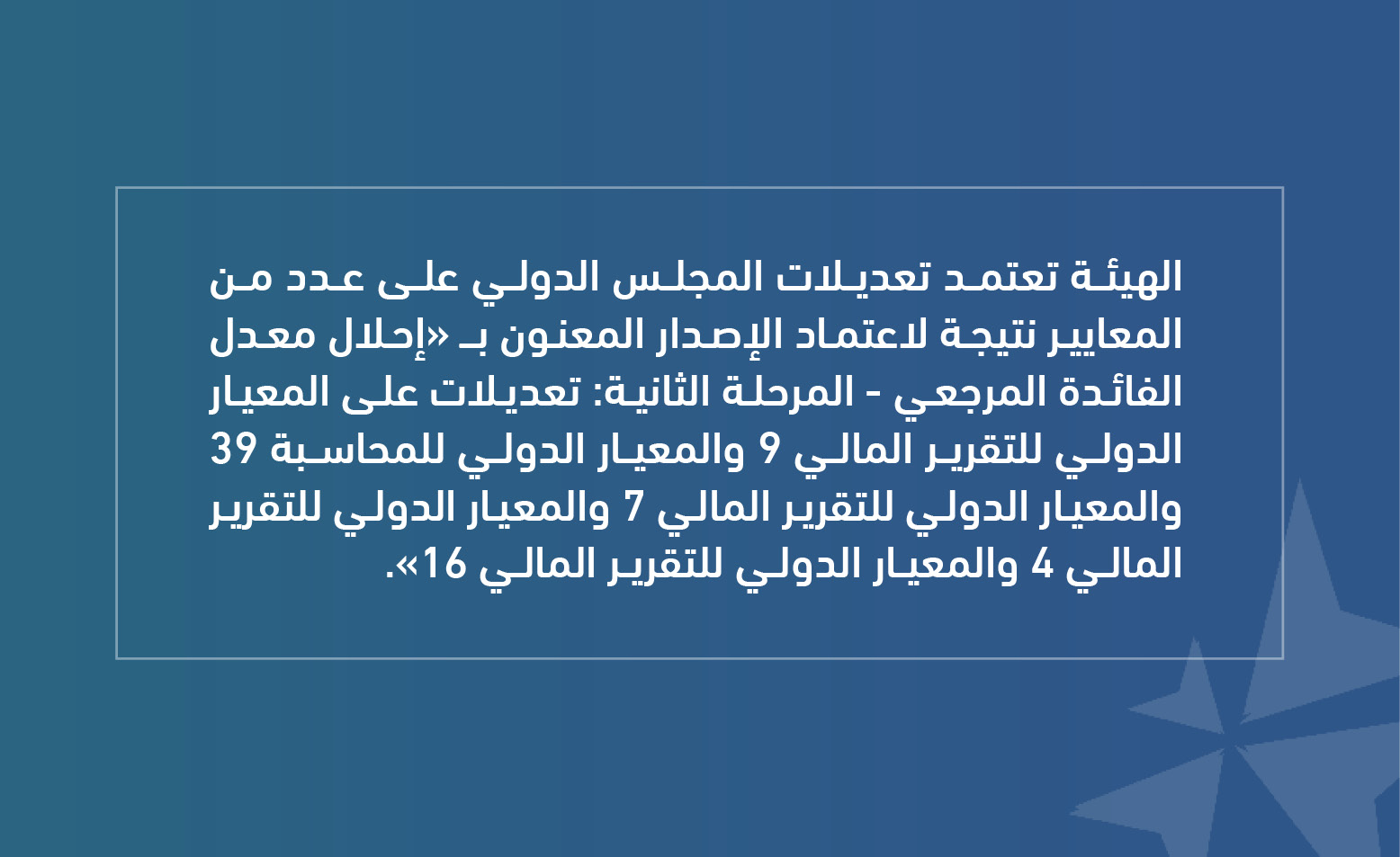SOCPA Adopts the Amendments of the International Board on a Number of Standards as a Result of the Adoption of the Version Entitled "Replacement of the Reference Interest Rate - Phase Two"

The Saudi Organization for Chartered and Professional Accountants, represented by the Accounting Standards Committee, adopted the amendments made by the International Accounting Standards Board on a number of its standards as a result of its completion and approval of the second phase of its project called “Replacement of the reference interest rate - the second phase.” These amendments covered both the International Financial Reporting Standard 9 and the International Accounting Standard 39, IFRS 7, IFRS 4, and IFRS 16.
Those amendments focus on providing exemptions from the requirements for revocation of evidence or amendment of contracts in the above-mentioned criteria, due to the change of the reference interest rate in those contracts.
With regard to IFRS 9 “Financial Instruments", the standard provides a practical method for accounting for the change required to replace the reference interest rate on the basis of determining the contractual cash flows of a financial asset or financial liability. This practical method is to deal with the replacement of the reference interest rate as well. If the entity deals with floating rates, which makes the substitution of the reference interest rate does not require a change in the basis for determining contractual cash flows unless two conditions are met:
1. That the change is necessary as a direct result of substituting the reference rate of interest;
2. That the new basis for determining contractual cash flows is economically equivalent to the previous basis (i.e. the basis immediately preceding the change).
The amendment established a number of examples that give rise to a new basis for determining contractual cash flows that are economically equivalent to the previous basis (i.e. the basis immediately preceding the change), and the procedures that must be taken if the changes required by the replacement of the reference interest rate are accompanied by other changes that affected the basis for determining contractual cash flows. .
The standard also provided a number of requirements to stop the temporary exemptions issued in its amendment that was made in the first stage of this project and related to the application of specific requirements for hedge accounting, as it defined the matters leading to the cessation of the application of those exemptions, and what the entities should do regarding the formal appointment of the hedging relationship. The standard determined the procedures to be followed if the entity makes other changes besides the changes it requires to replace the reference rate of interest on the financial asset or financial liability defined in the hedging relationship or the designation of the hedge relationship. The amendment also introduced requirements with respect to a number of hedging issues affected by the benchmark replacement, such as those related to cash flow hedges, item groups, and the designation of risk components. The International Board set the date of implementation at the beginning of the year 2021, with earlier application permitted.
With regard to IFRS 7 “Financial Instruments: Disclosures,” the amendment required disclosure of a set of information to enable users of financial statements to understand the effect of substituting a reference rate of interest on the entity’s financial statements and the risk management strategy, the most important of which is the nature and extent of risks to which the entity is facing, which arose from financial instruments that are subject to the replacement of the reference rate of interest, how the entity manages these risks, the progress made by the entity in accomplishing the transition to the alternative reference rates, and how the entity manages this transformation.
As for the International Financial Reporting Standard No. 4 “Insurance Contracts”, the amendment required the application of the paragraphs contained in the International Financial Reporting Standard No. 9 related to the practical method of accounting for the change required to replace the reference interest rate in the basis of determining the contractual cash flows of a financial asset or a financial liability. This applies to the financial asset or financial liability in the event that the basis for determining the contractual cash flows of that financial asset or financial liability changes as a result of substituting the reference interest rate.
With regard to IFRS 16 “Lease Contracts”, the standard added a number of paragraphs to deal with lease contract amendments that change the basis for determining future lease payments as a result of the substitution of the reference interest rate. In particular, the standard provided a practical means to deal with this type of amendment by applying the requirements of Paragraph 42 of that standard related to re-measuring the lease liabilities to discount the future cash flows of the lease payments if the following conditions are met.
That the amendment is necessary as a direct result of substituting the reference rate of interest;
That the new basis for determining lease payments is economically equivalent to the previous basis (i.e. the basis immediately preceding the amendment).
These amendments can be viewed by clicking here.